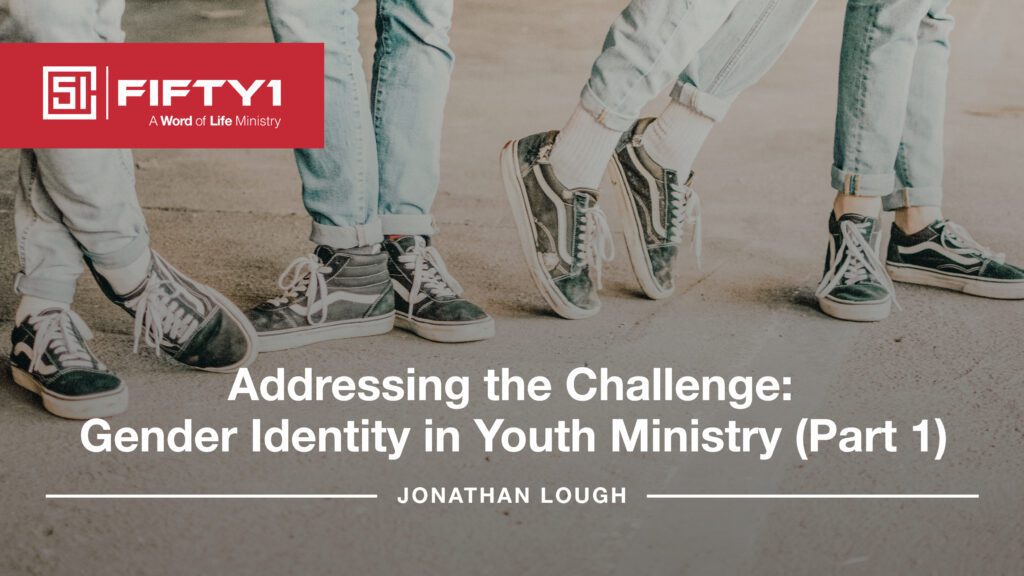One of the beautiful truths that has jumped out at me in the last several years is that the Bible remains profoundly relevant. “Gender identity” was hardly a concept until recently, yet an ancient book, the Bible, speaks to it. Within its pages, we find the truth this world desperately needs.
We also discover the Person of Jesus Christ, who exemplifies the best way to interact with those who struggle with the deep pain, confusion, and sin associated with gender identity issues. Based on the truth of the Bible and the example of Christ, I offer this blog and the next to answer three questions related to gender identity issues: Where are we now? How did we get here? How can we help those struggling with their gender identity? I will answer the first two questions in this blog and the final question in the next one.
Where Are We Now?
The Pew Research Center (2022) states that about 5 percent of young adults struggle with gender identity issues. These issues may include gender dysphoria, which is the experience of distress due to a perceived mismatch between one’s gender identity and biological sex, and transsexualism, which is the belief that one was born in the wrong body.
However, gender identity issues extend far beyond those who experience them. Another study put out by Ligonier Ministries (2022) shows that 47 percent of young people between ages 18 to 34 who hold to evangelical beliefs either strongly agree or somewhat agree that gender identity is a matter of choice. This reveals a sad reality — instead of the church’s doctrine seeping into and impacting the culture (as it should), the culture’s doctrine has seeped into the church.
How Did We Get Here?
To understand how the cultural ideas on gender identity have become so pervasive, we must go back to the beginning. God created a “very good” world and perfectly designed two sexes in His image, male and female (Gen. 1:27). But Adam sinned (Genesis 3). Since then, every break from God’s intended design and every skewed ideology ultimately traces back to Adam’s sin in the Fall.
Two skewed ideologies, which I will call “doctrines,” can be traced back to the fall and have given rise to the modern idea of “gender identity” — the doctrines of authenticity and authority. Understanding these doctrines will help us grasp how we got to where we are today.
According to the doctrine of authenticity, the “authentic self” can only be discovered when one acts outwardly according to one’s inward desires. Living according to one’s feelings is the chief end of man and the only way to be “authentic.” Anyone who refuses to live according to their genuine self is living a lie, and anyone who stifles another person’s genuine self is bigoted. Why? Because according to the doctrine of authority, the authentic self is sovereign and must be obeyed.
In my flesh, I like these doctrines! No wonder many young Christians find them appealing. But notice how these doctrines apply to gender identity. If your inner feelings tell you that you are the opposite sex, then you must obey your feelings so that you can be authentic. Instead of understanding authenticity as living according to God’s design, authenticity now means living according to a design determined by our feelings. And instead of placing God in His rightful position as the Authority, our authentic self now reigns supreme.
The development of these false doctrines in history demonstrates that since the fall, humanity has sought to displace God and become gods themselves, even attempting to alter God’s good and perfect design.
Gender Identity and Your Youth Group
Whether you realize it or not, the cultural doctrines of authenticity and authority reach into your church and youth group. Thankfully, scores of young people believe in the truth of God’s Word and refuse these cultural doctrines. Praise the Lord! But some young people in your youth group may have been captured by the fleshly appeal of living according to their “authentic selves.” They don’t struggle with any gender identity issues, but they have bought into the idea that gender identity is a choice. Further, there may be some young people in your youth group who struggle with gender dysphoria, transsexualism, or another gender-related issue. With these last two groups of people, how can you help them? Lord willing, I pray the next blog will help you get started.
For more information on this topic, read Andrew T. Walker’s “God and the Transgender Debate,” and Carl Trueman’s “Strange New World.”
Jonathan Lough is the assistant professor of theology at Word of Life Bible Institute in Pottersville, NY. He teaches Systematic Theology and Apologetics along with other classes as needed. Jon attended the Bible Institute for two years, served on a Word of Life traveling music team for one year, earned his bachelor’s degree at Cedarville University, and then graduated with his Master of Theology from Dallas Theological Seminary in 2022. Jon serves alongside his amazing wife, Lauren, whom he married in 2020.



1 thought on “Addressing the Challenge: Gender Identity in Youth Ministry (Part 1)”
Adolescence is part of childhood, a time of struggle, much like the struggle of a butterfly to get out of its cocoon. It is a necessary struggle to develop the coping skills that are needed in life. If you deny a child those years of learning to cope, he or she will become an inadequate adult, and suffer their whole lives. NO child should be allowed to have life-changing surgery or artificial hormone treatment. When they become an adult, which in our society is age 18, then they can do what they want. Until then they need to be helped along the way. They need help, not hormones.